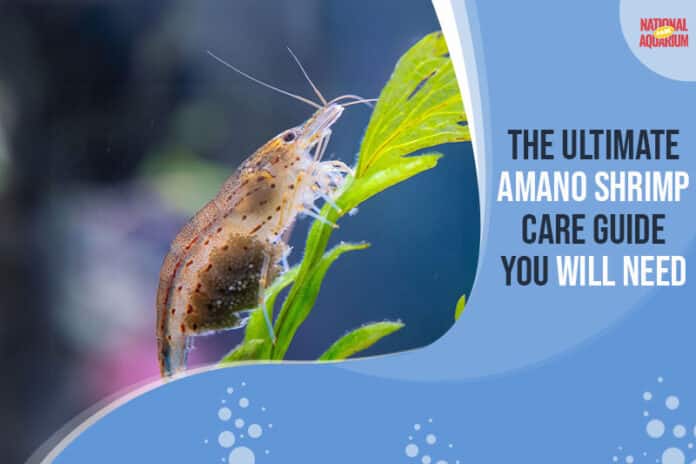Amano shrimp, with the scientific name Caridina multidentata, come from freshwater areas in Japan and Taiwan. They’re also called Yamato shrimp, Japanese shrimp, and algae shrimp. Many people who like to have fish tanks choose Amano shrimp because they’re strong, they don’t fight, and they really like to eat algae.
In this article, National Park Aquarium guides you on how to care for, breed, and understand the size, lifespan, etc. It provides an overview to help you improve your aquarium.
Why Are Amano Shrimp Popular?
Amano shrimp have gained popularity in the aquarium hobby due to their unique behavior, effective algae control, and distinctive looks, making them a desirable addition to freshwater environments.
Amano shrimp are popular for several reasons:
- Algae Control: Acting as mini vacuum cleaners, Amano shrimp efficiently consume various types of algae, keeping the tank clean.
- Easy Care: Amano shrimp are simple to care for, making them suitable for both beginners and experienced aquarium enthusiasts. They prefer a habitat with plants, clean water, and a variety of food.
- Peaceful Companions: Amano shrimp are peaceful and sociable, getting along well with many fish and other shrimp. They thrive in groups of at least four.
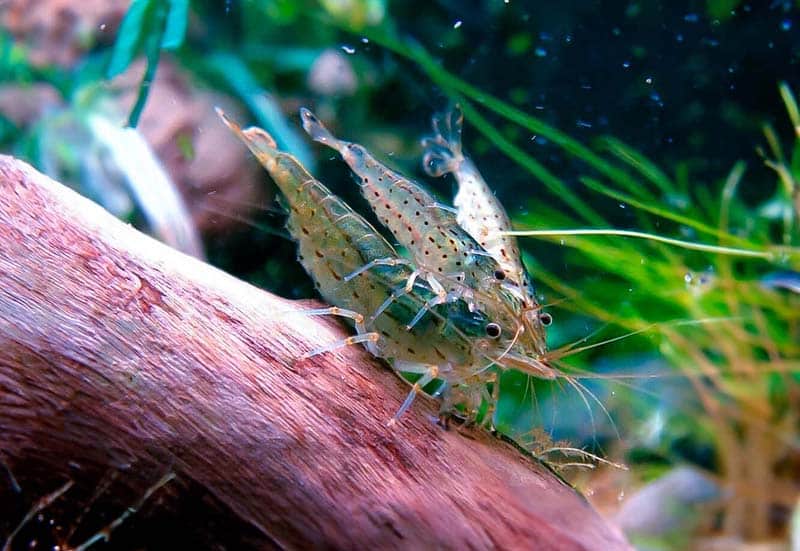
Amano Shrimp Color & Appearance
Amano Shrimp are known for their light grey, translucent color, which can sometimes exhibit shades of green, light brown, or light reddish-brown. Their bodies are adorned with solid dots and dashes that can be grayish-blue or reddish-brown, extending along their length. They also feature a lighter stripe on their topside that runs from head to tail. Notable features include their large eyes, long antennae, agile legs, and a broad, translucent tail.
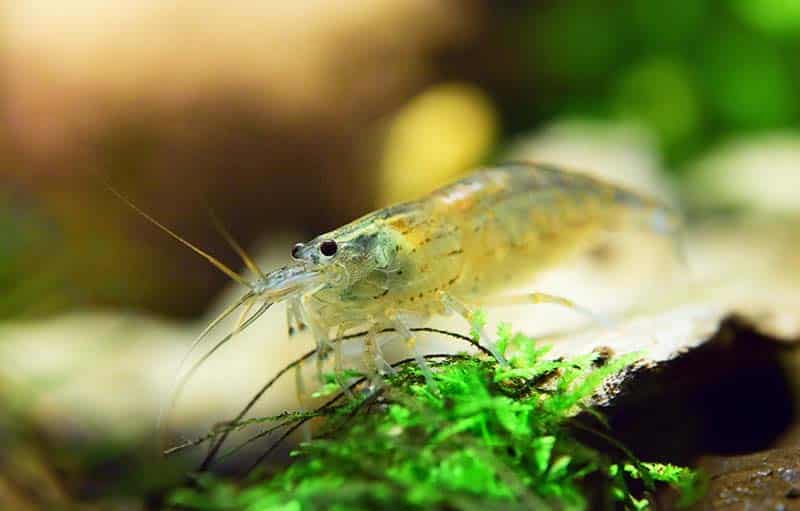
Amano Shrimp Size
Adult Amano shrimp size typically reach around 1.5 inches in length, though they can grow up to 2 inches. They grow relatively slowly, taking about 6-12 months to reach full size depending on factors like water temperature, diet, and overall health.
Amano Shrimp Lifespan
In the wild, Amano shrimp typically have a lifespan of 2-3 years. However, in captivity, it’s known that Amanos can survive up to 9 years, and even up to 15 years in some cases.
Some Pet stores might use a shorter lifespan as they don’t want customers to complain if their Amano doesn’t survive for 9 years. Sometimes they die shortly after being added to the tank. This could likely be a result of stress from transportation or changes in water parameters. But if the water conditions are right, food is plentiful, and there are no predators, these algae-eating shrimp can have a long and healthy life.
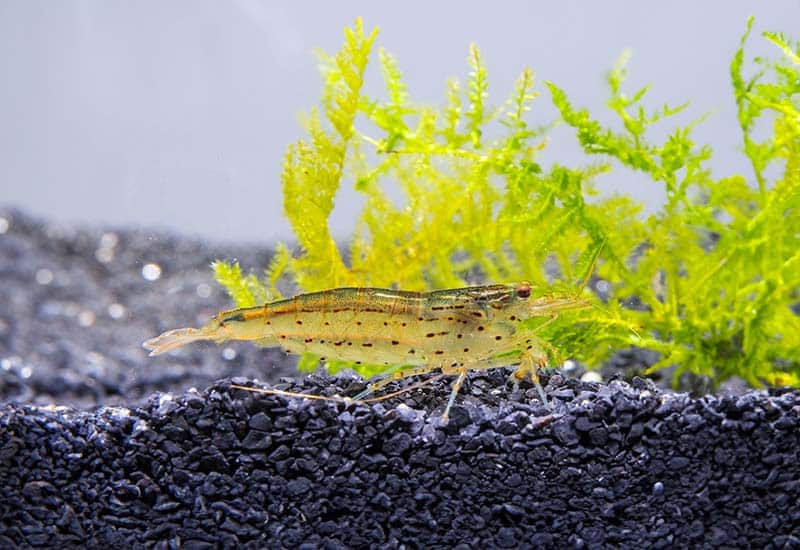
Amano Shrimp Care and Habitat Setup
Caring for Amano shrimp is relatively straightforward and doesn’t require much effort. Amano shrimp enjoy living in both small and large groups, cohabiting well with their own kind. They are comfortable in open spaces and enjoy exploring small hiding spots. They also appreciate anything in the tank that they can forage.
1. Tank Setup
Start with a spacious tank that holds at least 10 gallons. This gives Amano shrimp enough room to move around, and it’s perfect for keeping a small group of them together.
2. Water Parameters
Ensuring the right water conditions is crucial for these shrimps. The ideal Amano shrimp temperature range is 72-80°F. When it comes to pH, aim for a balanced environment between 6.5-7.5. And for water hardness, a soft to moderate level around 5-10 dKH is ideal.
3. Filtration
To guarantee the best water quality, a robust filter for shrimp tank system is a must. Whether you opt for a sponge filter or a hang-on-back type, ensure it functions efficiently, especially if your tank’s size leans on the smaller side.
4. Plants And Hiding Places
A well-planted tank offers Amano shrimp a playground full of hide-and-seek spots. Incorporate lush plants, driftwood, and caves. These elements not only add aesthetic value but also provide perfect nooks for shrimp to retreat and rest.
5. Maintenance
Routine maintenance keeps a shrimp’s home in tip-top shape. Remember to change some of the tank water regularly, ensuring a fresh environment. Also, it’s vital to remove any uneaten food and give the filter a thorough cleaning periodically. Keeping things clean promotes the health and happiness of your Amano shrimp.
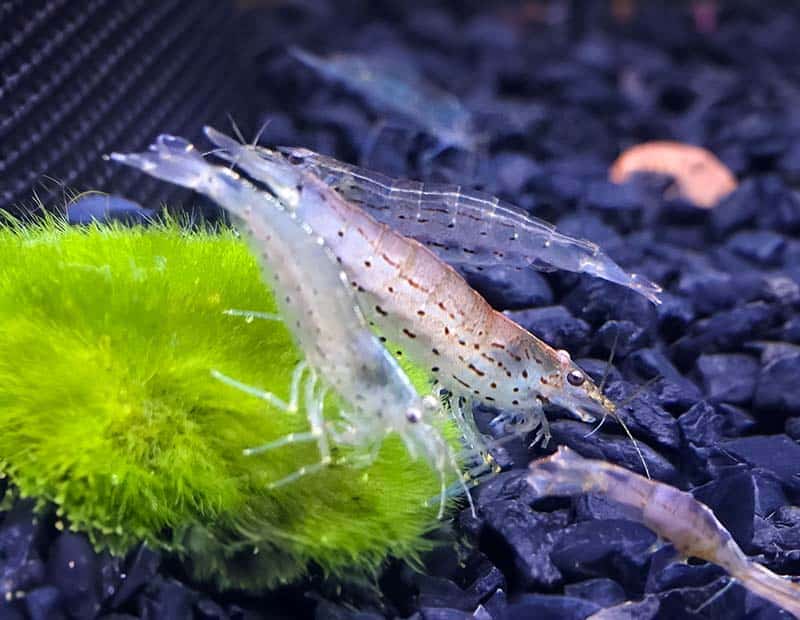
Amano Shrimp Feeding and Diet
Amano shrimp are curious little eaters. Being omnivores, they have a penchant for algae, which they munch on with great zeal. But their dietary tastes don’t end there. They also fancy biofilm, detritus, and even small invertebrates. To keep them healthy and active, it’s essential to offer them a rich mix of food sources to ensure they get all the nutrients they need.
- Algae wafers: A firm favorite, these offer a great source of nutrition.
- Blanched vegetables: Think zucchini, spinach, and carrots. Softened by a brief boil, they become delightful snacks for shrimp.
- Live food: Foods like brine shrimp, microworms, and daphnia are like luxury treats that also provide essential proteins.
- Commercial shrimp food: Quality matters. So, opt for a high-grade shrimp food from reputable brands.
Avoid overfeeding your shrimp as it’s crucial for their health. Leftover food can decompose in the tank, leading to harmful spikes in ammonia and nitrite levels, which are particularly lethal for Amanos. In a well-established tank, feeding your shrimp just 2-3 times a week is likely sufficient.
Amano Shrimp Breeding
Amano shrimp, while a bit tricky to breed in captivity, can reproduce if given the right conditions. A distinct feature of their breeding process is the need for brackish water – that’s a mix of freshwater and saltwater. The female shrimp releases her eggs, which are then fertilized by the male, leading to larvae that eventually transform into the adult shrimp we’re familiar with.
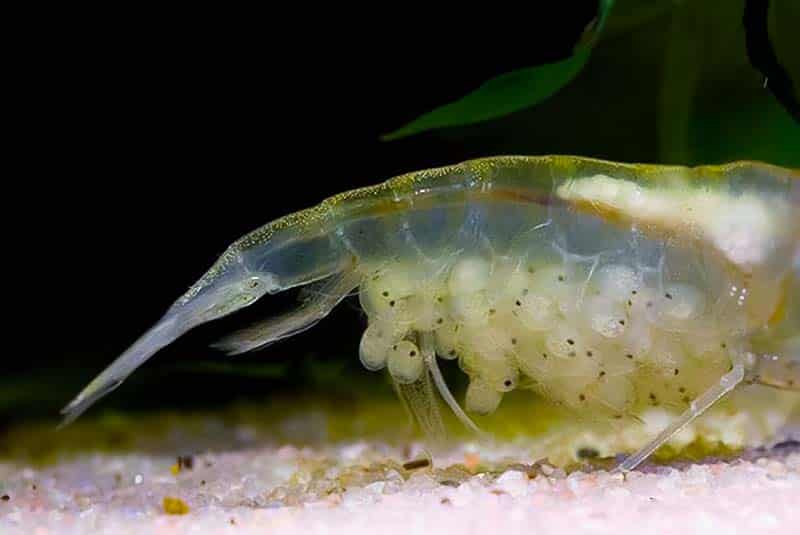
- Tank Setup: Create a dedicated breeding space using a separate tank filled with brackish water. Ensure that the salinity is around 10-15 ppt, which you can measure using a hydrometer.
- Introduce the Female: Post her molt, a female Amano shrimp will be prepared for mating, evident from a swollen saddle.
- Introduce the Male: The male shrimp will take charge and fertilize the female’s eggs.
- Egg Development: The female will carry these eggs, now developing, on her swimmerets for a few weeks. Ensure she’s well-fed and has sufficient places to hide during this time.
- Larvae Stage: Post hatching, the tiny and fragile larvae float around in the water. Feeding them requires care, with baby brine shrimp or microworms being ideal.
- Maturing: After a few weeks, these larvae will metamorphose into the adult form, and you can introduce them to your main aquarium.
To care for young Amano shrimp, ensure a plentiful diet of algae wafers, blanched veggies, and live food. Provide plants and rocks as hiding spots. Maintain clean water through regular changes and tests. Monitor their eating and growth, with any signs of lethargy or stunted growth indicating a need for isolation and special care.
Amano Shrimp Tank Mates
Amano shrimp are peaceful creatures and can coexist with a variety of tank mates. Here are some suitable companions for Amano shrimp:
- Neocaridina Shrimp: These species can easily live with each other without problems.
- Small Tetras, Rasboras, Danios: These small, peaceful fish won’t outcompete the shrimp for food.
- Guppies: They are peaceful and small enough to not pose a threat.
- Harlequin Rasboras: A peaceful schooling fish that enjoys the top of the tank, leaving the Amano shrimp undisturbed at the bottom.
- Chili Rasbora: Another great nano schooling fish.
- Apisto Borelli, Pearl Gourami, Bolivian Ram, Blue Ram, Lemon Tetras, Cory, Dwarf Neon Rainbow, Black Neon Tetra, Bushynose Pleco, Danios, Hillstream Loaches, Otocinclus, Cardinal Tetra: These are peaceful, small to mid-sized, community fishes.
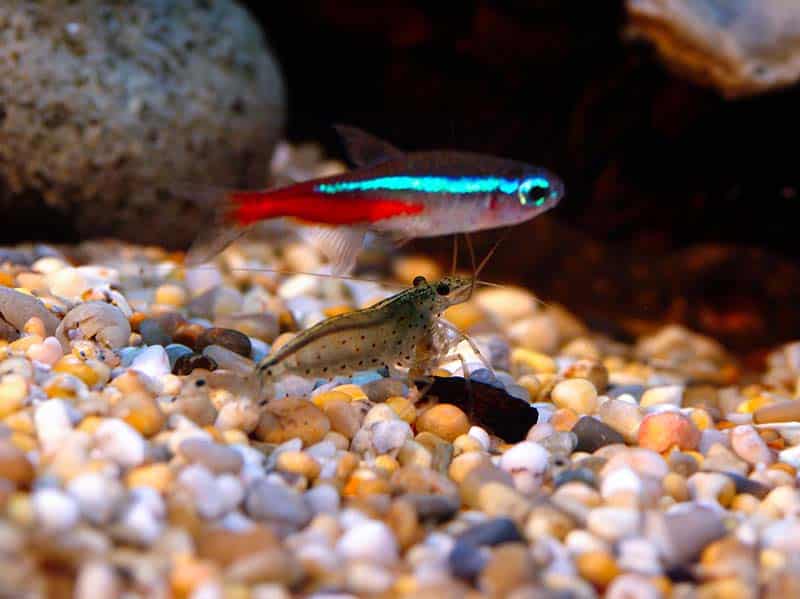
Remember, the key is to choose tank mates that are peaceful and won’t outcompete the shrimp for food. Always monitor the tank to ensure all species are cohabiting peacefully.
Gender Differences
Identifying the gender of Amano shrimp is relatively straightforward. Females are generally larger than males and possess a saddle on their hind abdomen where they store thousands of eggs. Additionally, the sex of the shrimp can be determined by the pattern of speckles or dots on their exoskeleton.
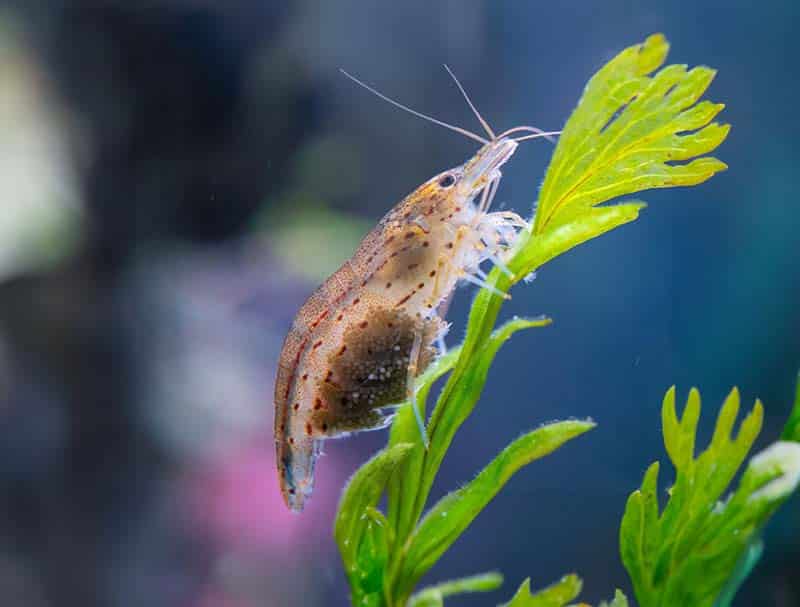
Amano Shrimp Molting
The molting process occurs when Amano shrimp shed their old shell and develop a new one. The empty shell can look like a lost shrimp, leading many beginners to think their shrimp has died.
Amano shrimp molt every 5 or 6 weeks, more or less. It can sometimes be difficult to determine the exact timing of the molt because Caridina Multidentata are often kept in larger groups. With all of them moving around, it’s hard to determine which shrimp molted when. Right after molting, Amano shrimp may feel vulnerable, so they might hide a bit until the new shell is ready.
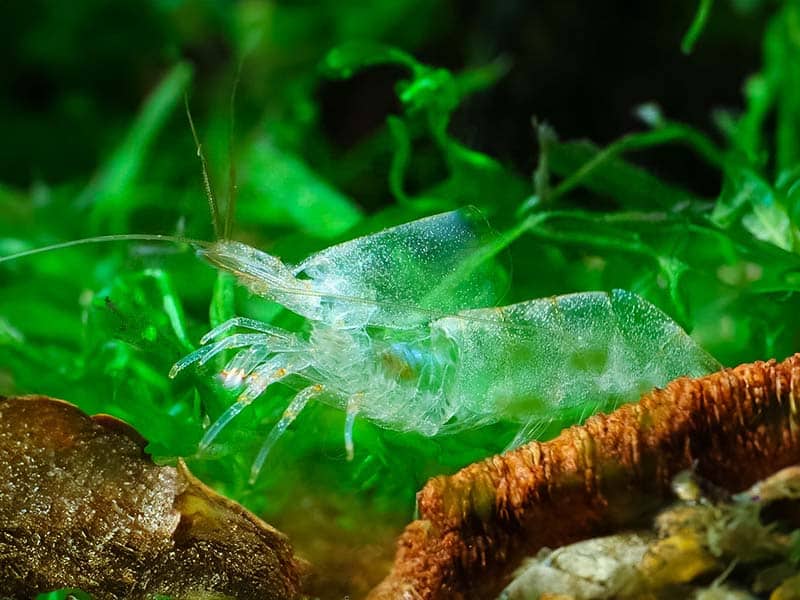
Conclusion
Amano shrimp are suitable for most aquariums, they help keep your tank algae-free and require less maintenance, they are also great community members in the tank as they are compatible with many peaceful fish species. Additionally, Amano shrimp have a long lifespan, so you can combine them to create a long-term ecosystem.
Learn more:

